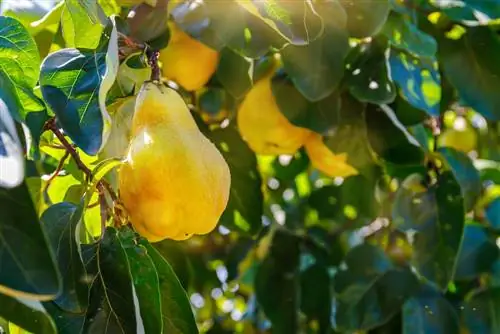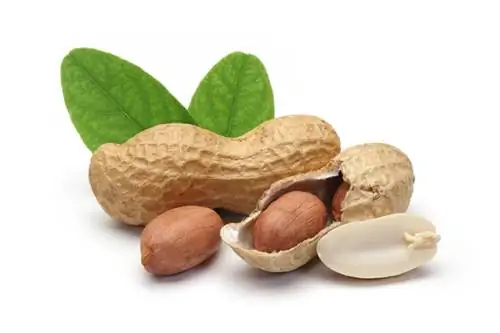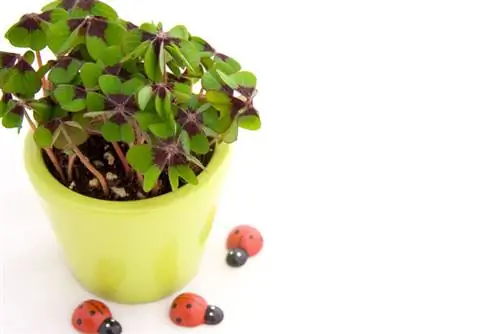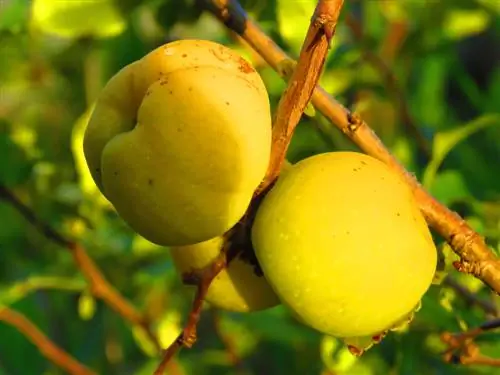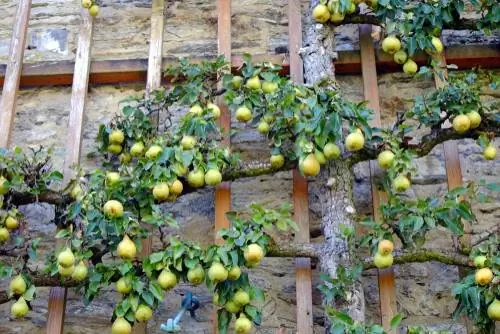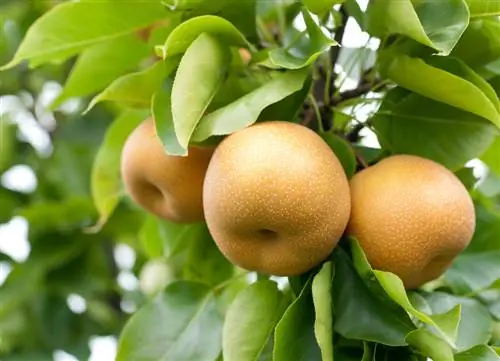- Author admin [email protected].
- Public 2023-12-16 16:46.
- Last modified 2025-01-23 11:22.
Read a commented pear quince profile here with information about growth, flowers, fruits and well-known varieties. Tried-and-tested tips explain how to properly plant and care for a quince tree.
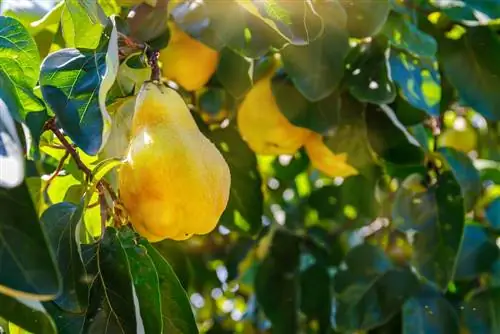
What is a pear quince?
The pear quince is a popular fruit variety from the genus Cydonia, which is known for its pear-shaped, golden yellow fruits. It thrives as a deciduous shrub or small tree, reaches a height of 3 to 5 meters and is often used for making compote, jam, jelly or quince bread.
Profile
- Scientific name: Cydonia
- Family: Rosaceae
- Tribus: Pome fruit family (Pyrinae)
- Occurrence: Europe, Asia
- Growth type: large shrub or small tree
- Growth height: 3 m to 5 m
- Leaf: egg-shaped
- Flower: fivefold, terminal
- Fruit: Gathering Skin Fruit
- Root system: deep roots
- Winter hardiness: hardy
- Use: boiled, steamed, baked
Growth
The pear quince is a type of the genus Cydonia, which is assigned to the subtribe pome fruit family (Pyrinae). The only plant species in this genus is the wild quince (Cydonia oblonga). From a botanical point of view, it is not a cross with true pears (Pyrus). This connection is reflected, among other things, in the fact that the furry fruits of a pear quince are not suitable for raw consumption. A quince tree makes up for the culinary shortcoming with these characteristic attributes:
- Growth type: deciduous shrub or small tree with pink-white flowers and aromatic, pear-shaped fruits for processing into juice, jelly, jam and compote.
- Growth form: tree-like, broad, upright shrub or short-stemmed small tree.
- Growth height: 300 cm to 500 cm.
- Growth width: 200 cm to 400 cm.
- Bark: initially felty, later smooth, brown-red.
- Root: Deep Roots
- Gardenically interesting properties: easy to care for, high-yielding, hardy, bee-friendly, high ornamental value, second variety not mandatory as a pollinator, long harvest time, compact fruit tree for the small garden.
Bloom
From information about the flowers on the quince tree, hobby gardeners gain important insights for productive cultivation. Flower ecology determines whether or not an additional pollinator is required. Flowering time and position are crucial for expert pruning care. You can read the key information you need to know about the pear quince flower in this overview:
- Flower shape: stalked, simple, bell-shaped, five-petaled with double perianth (5 hairy sepals, 5 ovate petals, 20 short stamens, 5 free styles).
- Flower color: white or pink.
- Flower size: 4 cm to 5 cm in diameter.
- flower ecology: hermaphrodite
- Position: terminal on annual shoots.
- Flowering time: May and June
With its flowers, the pear quince attracts visits from small bumblebees and other wild bees. The pollinators are rewarded with a rich nectar buffet at the bottom of the petals.
Fruit
Four to eight years after planting, a pear quince bears its first fruits with these characteristics:
- Fruit type: Pome fruit
- Fruit shape: pear-shaped on a 5 mm long, hairy fruit stalk.
- Fruit color: golden yellow when ripe.
- Special feature: seductively fragrant fruit, hard pulp with many seeds and stone cells under a furry shell.
Against the background of these fruit properties, it becomes clear: the pear quince is not a fruit to bite into. That's no reason to forego the fruity, tart fruit enjoyment. Quince lovers make a virtue out of necessity and use the fruit to make compote, jam, chutney, jelly or quince bread. You can find out how to master the preparation in the following video:
Video: The best tips for processing pear quince and apple quince
Pear quince varieties
The best pear quince varieties are chance seedlings of the wild quince (Cydonia oblonga) from Eastern Europe or were discovered in regions of Germany with mild winters. In tree nurseries, the floral delights are propagated through grafting so that the unique fruit qualities remain unchanged. The following table presents five favorites of German hobby gardeners in more detail:
| Pear Quince Varieties | Bereczki | Cydonia Robusta | Portuguese pear quince | Vranja | Pear Quince Westheim |
|---|---|---|---|---|---|
| Origin | Hungary | Geisenheim | Portugal | Serbia | Rhineland-Palatinate |
| Growth height | 300-400 cm | 350-550 cm | 300-500 cm | 300-400 cm | 250-300 cm |
| Speciality | big fruits | early flowering period from April | conditionally hardy, self-fertile | self-fertile | slow growth |
| Harvest time | from October | September to December | October to November | October to December | September to November |
| pulp | sweet-aromatic, mild | creamy yellow, few stone cells | white-yellow, juicy | medium firm, sweet and sour | white-yellow, juicy |
Although wild quince thrives with hermaphrodite flowers, a few pear quince varieties are not self-fertile. In general, the harvest yield is significantly higher if you provide each quince tree with a pollinator. Planting pear quince and apple quince in a double pack is recommended for the hobby garden.
Planting pear quince
You should buy ready-to-plant pear quinces as a graft from your trusted tree nursery. Because quince roots are extremely sensitive to frost, the nursery master grafts the noble variety onto a robust rootstock. The best time to plant is in autumn. You can find out where and how to properly plant a pear quince here:
Location
These are the optimal conditions for a pear quince in the garden:
- Sunny to partially shaded location, ideally with a south-west orientation.
- Normal garden soil, preferably nutrient-rich, fresh to slightly moist and permeable.
- Neutral to slightly acidic pH value (high lime content in the soil triggers leaf chlorosis).
An important criterion for choosing a location is crop rotation. If a stone fruit tree previously resided in the intended location, there are no concerns about impending soil fatigue. If the predecessor was a pome fruit tree, replace the bedding soil over a large area or plant the quince tree in another place.
Planting Tips
With the correct planting technique, the focus is on the grafting point on the quince tree. It makes sense to have protection against wind. Old varieties and some rootstocks tend to form annoying runners. Root products require root and plant pruning. You can read about what is really important when planting a pear quince in these tips & tricks:
- Preparation: place bare root and potted goods in water for a few hours.
- Excavation work: Dig out the planting pit, loosen the bottom thoroughly, line the pit with a rhizome barrier if necessary, mix the excavated material with compost soil.
- Root cutting: cut the main roots of the bare-root quince tree, remove damaged areas.
- Planting depth: the grafting point is 10 cm (one hand's width) above the soil surface.
- Support post: Drive in wooden posts 10 cm to 15 cm next to the trunk, connect with hose ties.
- Plant cutting: Cut back the central shoot by a third, leave 4 to 5 strong side branches as future leading branches of the tree crown and also shorten them, remove all remaining side shoots.
Finally, tamp down the soil and water the freshly planted quince tree generously.
Excursus
Pear Quince Apple Quince Difference
Beyond the characteristic fruit shape, there are these differences: The fruits of a pear quince are larger and contain fewer seeds and stone cells than an apple quince. Pear quince pulp has a softer consistency and a milder taste. In contrast, the spherical apple quinces impress with their particularly aromatic, albeit rock-hard, flesh.
Care for pear quince
With low-maintenance care, the pear quince becomes popular in the home garden. Water and nutrient supply are just as easy to manage as cutting care, harvesting and wintering. Read the best care tips here:
- Watering: in dry conditions, water with stale tap water or collected rainwater.
- Mulching: Mulch the tree disc regularly with compost, leaves or dried grass clippings.
- Fertilizing: fertilize in March with 3 liters of compost and 100 grams of horn shavings.
- Cutting: Cut the quince tree every 3 years in February, thin out dead wood, divert worn, exhausted fruit wood to a promising side shoot.
- Harvesting: harvest fruits with golden yellow skin from the end of September/beginning of October.
In the first few years of use, light winter protection is recommended. Cover the root slice with a layer of autumn leaves and spruce twigs. Older quince trees are completely hardy.
Popular varieties
Beyond the top 5 popular pear quinces, these historic varieties are vying for the hobby gardener's favor:
- Champion: robust variety, also known as champion quince, easy to care for, completely hardy, medium-firm, sweet-sour flesh.
- Franconian quince: Quince tree with pear-shaped, furry fruits that exude a spicy scent.
- Pineapple quince from the Aisch: Franconian country variety, medium-sized fruits, special quince scent with a sweet pineapple note.
- Bamberg Michelsberger Pear Quince: historical lover variety comes from a 130-year-old mother tree from Michelsberg, bears cylindrical, pointed fruits.
FAQ
Where in the garden can you plant a pear quince?
The pear quince wants a sunny, warm, ideally somewhat sheltered location. Icy easterly winds in winter cause the shoot tips to freeze back. The demands on the soil are modest. It should be normal garden soil. Preferably loose, humus-rich, nutrient-rich and slightly moist. Exclusion criteria are high lime content and waterlogging.
Are invasive runners to be feared on the quince tree?
A grafted pear quince generally does not produce runners that infiltrate the garden. Things look different with old pear quince varieties that come from propagation by sowing. These quince trees can certainly sprout runners, sometimes with an invasive character. If you plant an ungrafted quince seedling, we recommend using a rhizome barrier.
Is the pear quince self-fertile?
In terms of fertilization behavior, quince trees are divided into indeterminate, self-infertile and self-fertile varieties. The self-fertile varieties are in the majority. These include almost all known pear quince varieties, such as Bereczki, Vranja, Portuguese pear quince or Champion. The degree of fertilization in individual positions is sufficient for use in the home garden. In general, the harvest yield can be significantly increased, even from self-fertile fruit trees, if you plant two quince trees.
My pear quince bore two fruits for the first time in autumn. Is pruning necessary now?
Pruning care for a pear quince is usually limited to a thinning cut. If the treetop becomes so dense that the sun's rays can no longer penetrate, you should use pruning shears. The best time is the end of February when the weather is frost-free. On the other hand, if the harvest leaves something to be desired, you can increase profitability. Horizontal branches produce the best fruiting wood. For this purpose, steeply upward shoots are removed or tied into a horizontal position.
Is the pear quince hardy?
As a rule, all pear quince varieties in Germany are hardy. The degree of winter hardiness depends on various factors: A quince tree is fertilized for the last time in July so that the branches mature before the first frost. The wood is not exposed to direct east or north winds in winter. Furthermore, very wet or dry soil can have a negative impact on winter hardiness.

